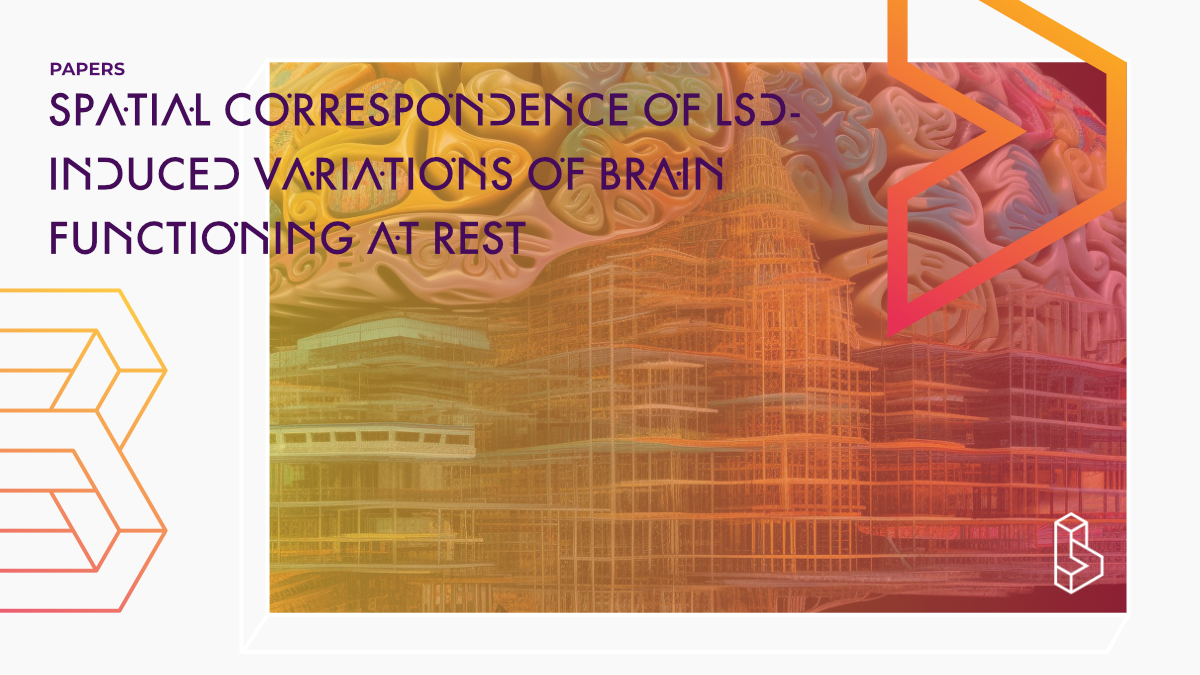This analysis of resting-state fMRI (n=15) of LSD (75μg) effects on the brain finds modifications in serotonin receptor-rich areas. The local signal amplitude and functional connectivity (FC) increased in the default mode network (DMN) and attention networks (rich in serotonin 2a receptors). A decrease was seen in limbic areas (with many serotonin 1a receptors).
Abstract
“Background Lysergic acid diethylamide (LSD) is an atypical psychedelic compound exerting its effects through pleiotropic actions, mainly involving 1A/2A serotoninergic (5-HT) receptor subtypes. However, the mechanisms by which LSD promotes a reorganization of the brain’s functional activity and connectivity are still partially unknown.
Methods Our study analyzed resting-state functional magnetic resonance imaging (rs-fMRI) data acquired from fifteen healthy volunteers undergoing LSD acute intake. A voxel-wise analysis investigated the alterations of the brain’s intrinsic functional connectivity and local signal amplitude induced by LSD or by a placebo. Quantitative comparisons assessed the spatial overlap between these two indices of functional reorganization and the topography of receptor expression obtained from a publicly available collection of in-vivo, whole-brain atlases. Finally, linear regression models explored the relationships between changes in rs-fMRI and behavioral aspects of the psychedelic experience.
Results LSD elicited modifications of the cortical functional architecture that spatially overlapped with the distribution of serotoninergic receptors. Local signal amplitude and functional connectivity increased in regions belonging to the default mode and attention networks associated with high expression of 5-HT2A receptors. These functional changes correlate with the occurrence of simple and complex visual hallucinations. At the same time, a decrease in local signal amplitude and intrinsic connectivity was observed in limbic areas, which are dense with 5-HT1A receptors.
Conclusions This study provides new insights into the neural processes underlying the brain network reconfiguration induced by LSD. It also identifies a topographical relationship between opposite effects on brain functioning and the spatial distribution of different 5-HT receptors.”
Authors: Stefano D. Pizzi, Piero Chiacchiaretta, Carlo Sestieri, Antonio Ferretti, Marco Onofrj, Stefania D. Penna, Leor Roseman, Christopher B. Timmermann, David J. Nutt, Robin L. Carhart-Harris & Stefano L. Sensi
Summary of Spatial correspondence of LSD-induced variations of brain functioning at rest with serotonin receptor expression
LSD is an atypical psychedelic compound that exerts pleiotropic (disorders where multiple, seemingly unrelated organ systems are affected) actions on the 5-HT1A subtype. Non-invasive neuroimaging studies have shown that LSD significantly increases between-network cortico-cortical functional connections.
A promising approach to understanding the effects of LSD on brain blood oxygenation level-dependent (BOLD) response and neurotransmission is to integrate fMRI data with brain atlases depicting the ex-vivo expression of genes coding for receptors activated by LSD. Using voxel-based approaches, researchers have shown that LSD increases global connectivity and the integration between high-level association cortices, decreasing associative areas’ connectivity weight. This phenomenon qualitatively overlaps with the map of 5-HT2A receptor density.
Study details
Compounds studied
LSD
Topics studied
Neuroscience
Study characteristics
Participants
15
Humans
Authors
Authors associated with this publication with profiles on Blossom
Robin Carhart-HarrisDr. Robin Carhart-Harris is the Founding Director of the Neuroscape Psychedelics Division at UCSF. Previously he led the Psychedelic group at Imperial College London.
Chris Timmermann
Chris Timmerman is a postdoc at Imperial College London. His research is mostly focussed on DMT.
David Nutt
David John Nutt is a great advocate for looking at drugs and their harm objectively and scientifically. This got him dismissed as ACMD (Advisory Council on the Misuse of Drugs) chairman.
Linked Research Papers
Notable research papers that build on or are influenced by this paper
Neural correlates of the LSD experience revealed by multimodal neuroimagingUsing three different neuroimaging techniques (ASL, BOLD, MEG), this single-blind, placebo-controlled study highlighted the neurological underpinnings of the LSD/psychedelic (75μg) experience.

